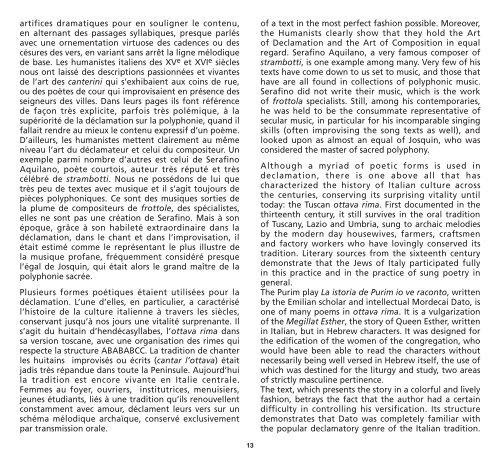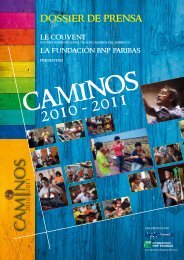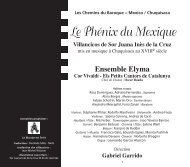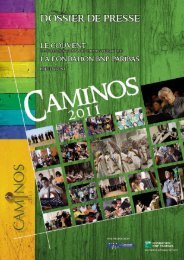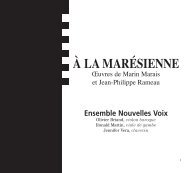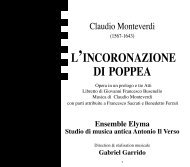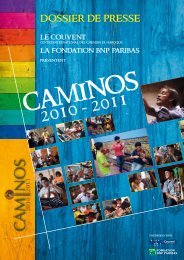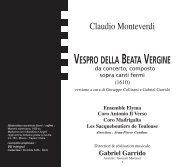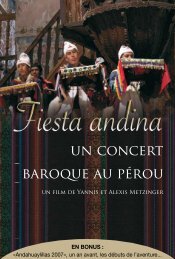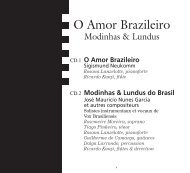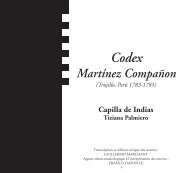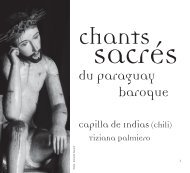Musique et poésie des Juifs en Italie à la Renaissance Music and ...
Musique et poésie des Juifs en Italie à la Renaissance Music and ...
Musique et poésie des Juifs en Italie à la Renaissance Music and ...
- No tags were found...
Create successful ePaper yourself
Turn your PDF publications into a flip-book with our unique Google optimized e-Paper software.
artifices dramatiques pour <strong>en</strong> souligner le cont<strong>en</strong>u,<strong>en</strong> alternant <strong>des</strong> passages syl<strong>la</strong>biques, presque parlésavec une ornem<strong>en</strong>tation virtuose <strong>des</strong> cad<strong>en</strong>ces ou <strong>des</strong>césures <strong>des</strong> vers, <strong>en</strong> variant sans arrêt <strong>la</strong> ligne mélodiquede base. Les humanistes itali<strong>en</strong>s <strong>des</strong> XV e <strong>et</strong> XVI e sièclesnous ont <strong>la</strong>issé <strong>des</strong> <strong>des</strong>criptions passionnées <strong>et</strong> vivantesde l’art <strong>des</strong> canterini qui s’exhibai<strong>en</strong>t aux coins de rue,ou <strong>des</strong> poètes de cour qui improvisai<strong>en</strong>t <strong>en</strong> prés<strong>en</strong>ce <strong>des</strong>seigneurs <strong>des</strong> villes. Dans leurs pages ils font référ<strong>en</strong>cede façon très explicite, parfois très polémique, à <strong>la</strong>supériorité de <strong>la</strong> déc<strong>la</strong>mation sur <strong>la</strong> polyphonie, qu<strong>and</strong> ilfal<strong>la</strong>it r<strong>en</strong>dre au mieux le cont<strong>en</strong>u expressif d’un poème.D’ailleurs, les humanistes m<strong>et</strong>t<strong>en</strong>t c<strong>la</strong>irem<strong>en</strong>t au mêm<strong>en</strong>iveau l’art du déc<strong>la</strong>mateur <strong>et</strong> celui du compositeur. Unexemple parmi nombre d’autres est celui de SerafinoAqui<strong>la</strong>no, poète courtois, auteur très réputé <strong>et</strong> trèscélébré de strambotti. Nous ne possédons de lui qu<strong>et</strong>rès peu de textes avec musique <strong>et</strong> il s’agit toujours depièces polyphoniques. Ce sont <strong>des</strong> musiques sorties de<strong>la</strong> plume de compositeurs de frottole, <strong>des</strong> spécialistes,elles ne sont pas une création de Serafino. Mais à sonépoque, grâce à son habil<strong>et</strong>é extraordinaire dans <strong>la</strong>déc<strong>la</strong>mation, dans le chant <strong>et</strong> dans l’improvisation, ilétait estimé comme le représ<strong>en</strong>tant le plus illustre de<strong>la</strong> musique profane, fréquemm<strong>en</strong>t considéré presquel’égal de Josquin, qui était alors le gr<strong>and</strong> maître de <strong>la</strong>polyphonie sacrée.Plusieurs formes poétiques étai<strong>en</strong>t utilisées pour <strong>la</strong>déc<strong>la</strong>mation. L’une d’elles, <strong>en</strong> particulier, a caractérisél’histoire de <strong>la</strong> culture itali<strong>en</strong>ne à travers les siècles,conservant jusqu’à nos jours une vitalité surpr<strong>en</strong>ante. Ils’agit du huitain d’h<strong>en</strong>décasyl<strong>la</strong>bes, l’ottava rima danssa version toscane, avec une organisation <strong>des</strong> rimes quirespecte <strong>la</strong> structure ABABABCC. La tradition de chanterles huitains improvisés ou écrits (cantar l’ottava) étaitjadis très rép<strong>and</strong>ue dans toute <strong>la</strong> P<strong>en</strong>insule. Aujourd’hui<strong>la</strong> tradition est <strong>en</strong>core vivante <strong>en</strong> <strong>Italie</strong> c<strong>en</strong>trale.Femmes au foyer, ouvriers, institutrices, m<strong>en</strong>uisiers,jeunes étudiants, liés à une tradition qu’ils r<strong>en</strong>ouvell<strong>en</strong>tconstamm<strong>en</strong>t avec amour, déc<strong>la</strong>m<strong>en</strong>t leurs vers sur unschéma mélodique archaïque, conservé exclusivem<strong>en</strong>tpar transmission orale.of a text in the most perfect fashion possible. Moreover,the Humanists clearly show that they hold the Artof Dec<strong>la</strong>mation <strong>and</strong> the Art of Composition in equalregard. Serafino Aqui<strong>la</strong>no, a very famous composer ofstrambotti, is one example among many. Very few of histexts have come down to us s<strong>et</strong> to music, <strong>and</strong> those thathave are all found in collections of polyphonic music.Serafino did not write their music, which is the workof frotto<strong>la</strong> specialists. Still, among his contemporaries,he was held to be the consummate repres<strong>en</strong>tative ofsecu<strong>la</strong>r music, in particu<strong>la</strong>r for his incomparable singingskills (oft<strong>en</strong> improvising the song texts as well), <strong>and</strong>looked upon as almost an equal of Josquin, who wasconsidered the master of sacred polyphony.Although a myriad of po<strong>et</strong>ic forms is used indec<strong>la</strong>mation, there is one above all that hascharacterized the history of Italian culture acrossthe c<strong>en</strong>turies, conserving its surprising vitality untiltoday: the Tuscan ottava rima. First docum<strong>en</strong>ted in th<strong>et</strong>hirte<strong>en</strong>th c<strong>en</strong>tury, it still survives in the oral traditionof Tuscany, Lazio <strong>and</strong> Umbria, sung to archaic melodiesby the modern day housewives, farmers, craftsm<strong>en</strong><strong>and</strong> factory workers who have lovingly conserved itstradition. Literary sources from the sixte<strong>en</strong>th c<strong>en</strong>turydemonstrate that the Jews of Italy participated fullyin this practice <strong>and</strong> in the practice of sung po<strong>et</strong>ry ing<strong>en</strong>eral.The Purim p<strong>la</strong>y La istoria de Purim io ve raconto, writt<strong>en</strong>by the Emilian scho<strong>la</strong>r <strong>and</strong> intellectual Mordecai Dato, isone of many poems in ottava rima. It is a vulgarizationof the Megil<strong>la</strong>t Esther, the story of Que<strong>en</strong> Esther, writt<strong>en</strong>in Italian, but in Hebrew characters. It was <strong>des</strong>igned forthe edification of the wom<strong>en</strong> of the congregation, whowould have be<strong>en</strong> able to read the characters withoutnecessarily being well versed in Hebrew itself, the use ofwhich was <strong>des</strong>tined for the liturgy <strong>and</strong> study, two areasof strictly masculine pertin<strong>en</strong>ce.The text, which pres<strong>en</strong>ts the story in a colorful <strong>and</strong> livelyfashion, b<strong>et</strong>rays the fact that the author had a certaindifficulty in controlling his versification. Its structuredemonstrates that Dato was compl<strong>et</strong>ely familiar withthe popu<strong>la</strong>r dec<strong>la</strong>matory g<strong>en</strong>re of the Italian tradition.13


